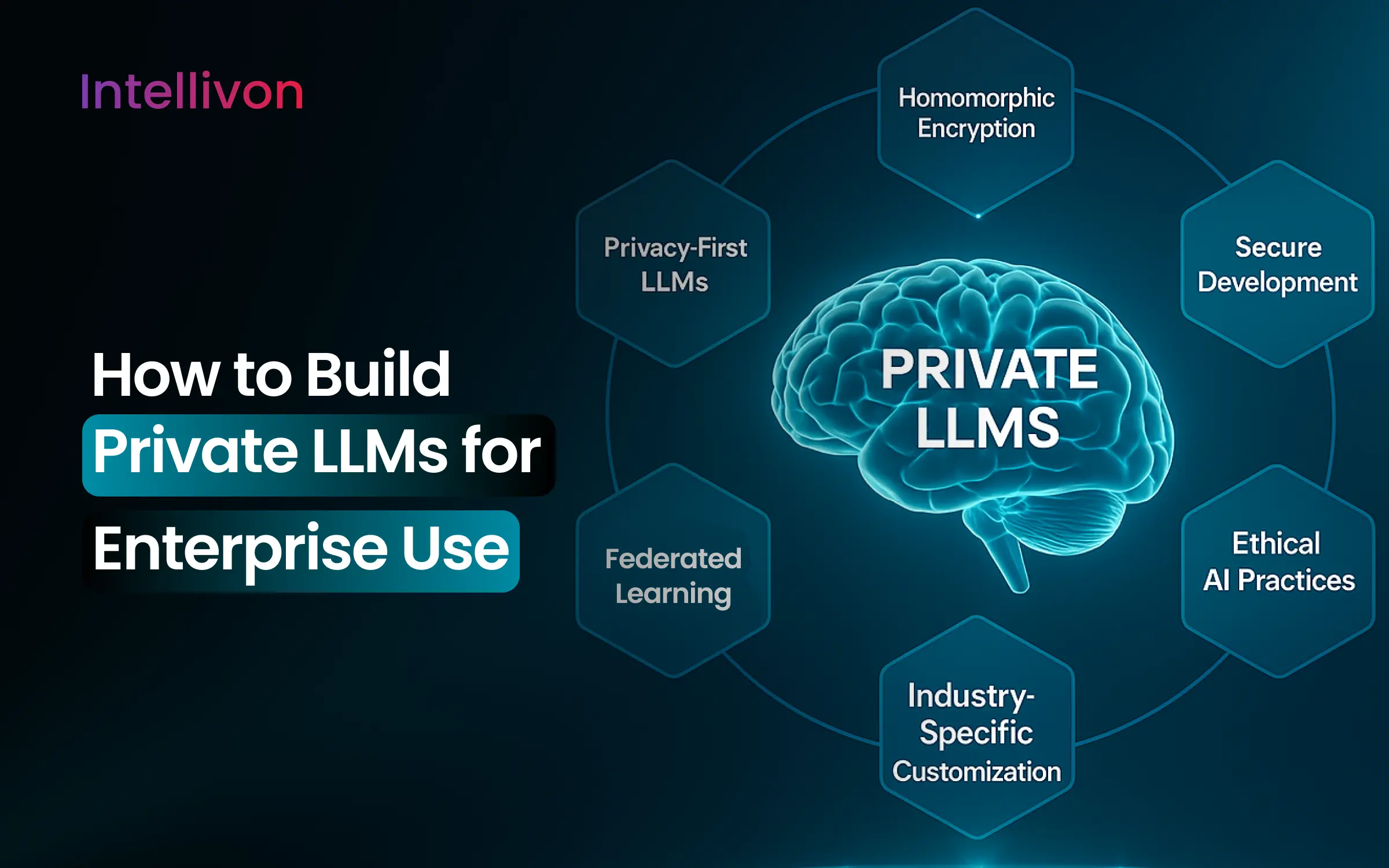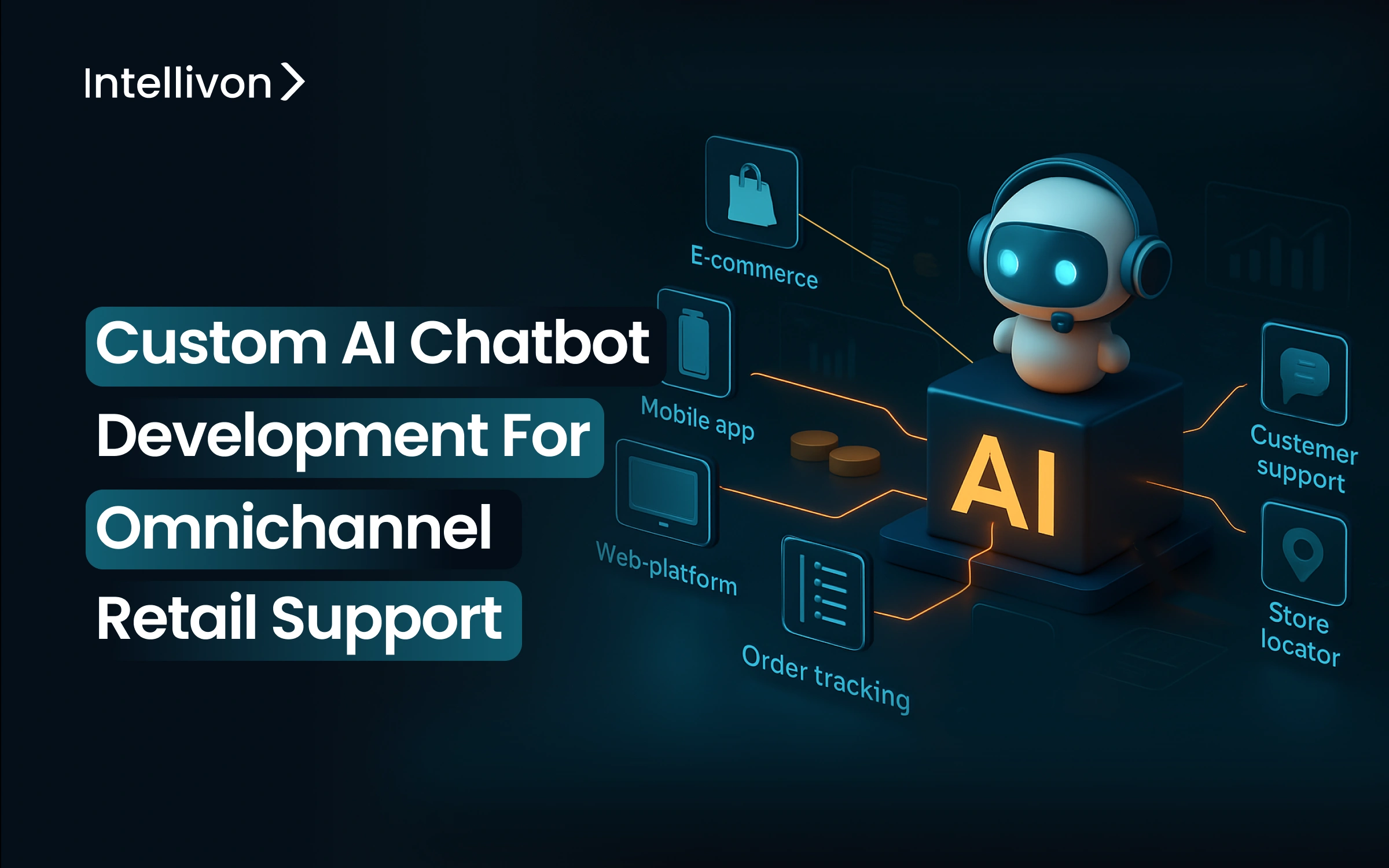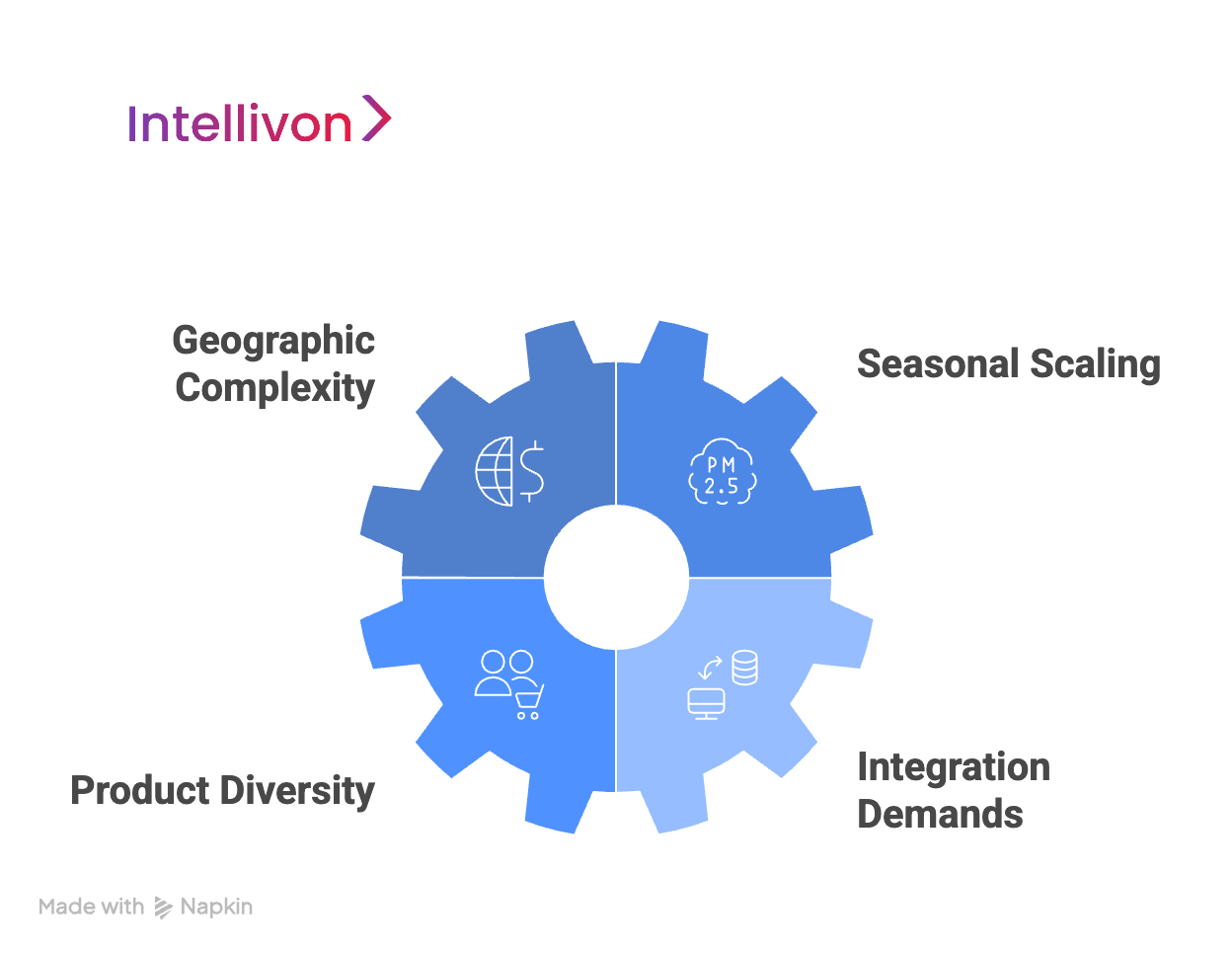Chatbots are taking over the global retail enterprise space as customer demands evolve and hyper-personalized product suggestions become prominent. In this changing retail landscape, retail enterprises face a critical challenge: providing seamless support across multiple touchpoints. Custom AI chatbots have become a game-changer in meeting this challenge by achieving true omnichannel support.
Already, 70% of medium to large enterprises are using AI Chatbots to streamline customer support, and a record 62% of customers would rather use a chatbot than wait for a human agent to answer their questions. When omnichannel customer support is optimized, the likelihood of customers abandoning their carts or leaving a site before completing a purchase significantly decreases. In fact, customers are 80% more likely to finalize a transaction when their questions are addressed accurately and immediately. This seamless support experience directly contributes to increased sales and improved conversion rates.
In this blog, we will explore how custom AI chatbots can enhance omnichannel retail experiences, how much it costs to get one developed, and some real-life use cases of retail giants leveraging chatbots to stay ahead of the competition. As a leading AI solutions provider, Intellivon has been at the forefront of developing innovative, customized AI chatbot solutions that help enterprises scale their customer support operations efficiently across all platforms.
Why Leading Retail Enterprises Are Using AI Chatbots For Omnichannel Support
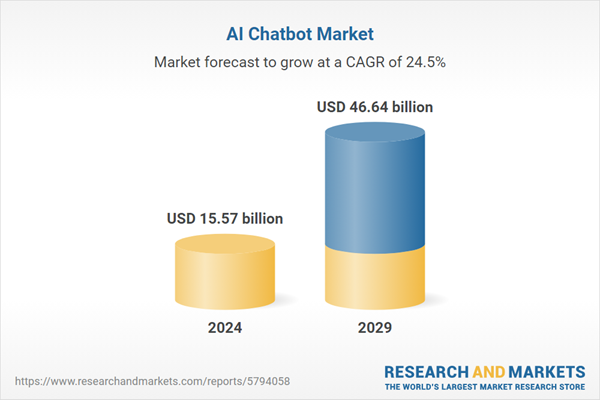
Take a look at these statistics surrounding the AI chatbot market:
- By 2027, chatbots are expected to be the main customer service channel for 25% of all organizations.
- Shoppers interacting with AI chat are four times more likely to complete a purchase (12.3% vs. 3.1%).
- Purchases are completed 47% faster with the help of AI.
- Chatbots can boost eCommerce revenue by 7% to 25%.
- AI chatbots can handle up to 80% of routine queries without human help, saving businesses billions in labor costs.
This is why custom AI chatbots become a pivotal tool in achieving true omnichannel support for leading retail enterprises. The question, however, remains: Are you ready to reap the benefits of AI chatbots for your enterprise? Book a strategy call with us and get your omnichannel support AI Chatbot developed and integrated.
Why is Omnichannel Support Essential for Global Retailers?
In today’s competitive retail landscape, customers don’t think in terms of separate channels. Instead, they focus on the experience. As they move between online platforms, mobile apps, and physical stores, they expect the same level of service regardless of how they engage. Omnichannel support has become a necessity for global retailers aiming to stay competitive.
1. Customer Expectations are Higher
Consumers today demand convenience, consistency, and personalization. A fractured customer experience, where service quality varies by channel, can lead to frustration and lost sales.
2. Preventing Cart Abandonment
Studies show that when customers experience inconsistent service across channels, they are far more likely to abandon their shopping carts. For global retailers, this leads to missed revenue opportunities and lower conversion rates.
3. Improved Customer Retention
With a solid omnichannel strategy, global retailers can significantly improve customer retention rates. A seamless experience across platforms makes customers more likely to return and engage with the brand, fostering long-term loyalty.
4. Valuable Insights from Unified Data
Omnichannel support not only enhances the customer experience but also provides a wealth of data. By consolidating information from various touchpoints, retailers can gain deeper insights into consumer behavior, enabling better decision-making and more effective marketing strategies.
The Role of AI in Omnichannel Support
Custom AI chatbots have become a core component of omnichannel support, offering retailers a scalable solution to provide consistent, high-quality service across all customer touchpoints. These intelligent systems ensure that customers receive fast, accurate, and personalized support, regardless of how they engage with the brand.
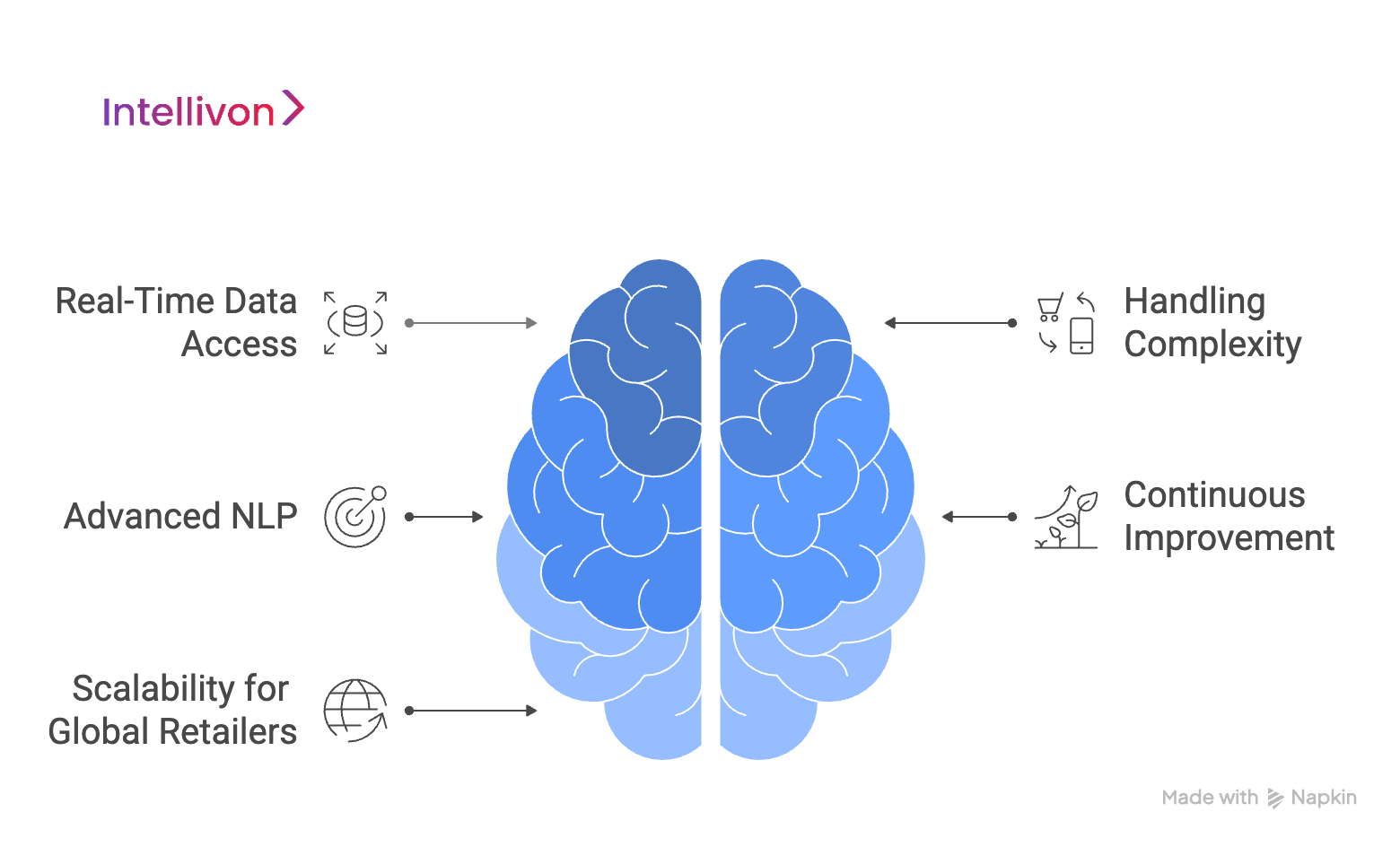
1. Real-Time Data Access
Custom AI chatbots instantly access a customer’s full interaction history, purchase records, preferences, and previous inquiries. This real-time data enables the chatbot to provide responses that are both personalized and contextually relevant, ensuring a seamless customer experience.
2. Handling Complexity
AI chatbots can manage the complexities of modern retail operations by checking inventory levels, processing returns, offering personalized product recommendations, and even coordinating with in-store staff for a smooth pickup or delivery experience.
3. Advanced Natural Language Processing
Using advanced NLP, AI chatbots understand customer intent, emotional context, and urgency. This allows them to prioritize inquiries, escalate complex issues to human agents with full context, and proactively reach out to customers when potential issues are identified.
4. Continuous Improvement
AI chatbots learn and improve with every interaction. The more they interact with customers, the better they become at understanding customer needs and resolving issues. This continuous learning process ensures that your omnichannel support becomes more effective over time.
5. Scalability for Global Retailers
Whether serving ten customers or ten million, AI chatbots provide consistent, high-quality service without the need for proportional increases in support staff. This makes AI an essential tool for global retailers looking to scale their customer service operations without compromising quality.
By integrating AI-powered chatbots into an omnichannel strategy, retailers can not only improve the customer experience but also achieve significant operational efficiencies. AI enables retailers to handle an increasing volume of customer interactions while maintaining high standards of service, ensuring they stay competitive in an increasingly complex marketplace.
Why Traditional Chatbots Are Failing In the Retail Space
Over 70% enterprises are making the switch to AI chatbots for omnichannel support. Enterprises that still use traditional customer support operations are severely lagging in sales and consumer satisfaction rates. This is because off-the-shelf chatbots operate in silos. They might work adequately on your website, but they fail catastrophically when customers expect the same intelligence across your mobile app, social media, and in-store kiosks.
The Multi-Channel Reality
Today’s retail customers are not confined to thinking in terms of channels; they focus on moments. Whether it’s researching a product during lunch on their mobile phone, browsing for deals on a desktop at home, or visiting a physical store on the weekends, customers expect one continuous, integrated experience. They want to move seamlessly between these touchpoints without feeling like they’re starting over each time.
The Hidden Cost of Fragmentation
When customer interactions are disconnected across various platforms, the consequences can be detrimental to both sales and brand loyalty.
- 67% of customers abandon purchases due to poor cross-channel experiences
- Retailers lose an average of $62 billion annually to disconnected customer journeys
- It takes 12 positive experiences to make up for one negative interaction
For example, a global retailer like Nike has worked hard to ensure that their app, website, and in-store experience are all integrated. Suppose a customer adds items to their cart on the mobile app but encounters issues when they try to complete the purchase on their desktop or in-store. In that case, it disrupts the entire shopping journey, often leading to abandoned transactions.
By ensuring a seamless customer experience across every channel, brands like Nike have been able to retain customer loyalty and drive conversions more effectively.
The Generic Limitation
Traditional chatbots are typically designed to function within isolated systems. While they might handle basic inquiries well on a website, they often fail when customers expect the same level of service across multiple platforms, such as mobile apps, social media, or in-store kiosks.
Off-the-shelf, generic chatbots lack the flexibility and customization needed to deliver a high-quality omnichannel experience. Their limitations include:
- No understanding of your specific retail processes
- Unable to access real-time inventory across locations
- Disconnected from your customer data and purchase history
- Limited integration with existing retail systems
A clear example of this can be seen with H&M, where their traditional chatbot on their website offers basic customer service, such as tracking orders or answering FAQs. However, when a customer tries to inquire about stock levels at a nearby store via mobile or social media, the chatbot fails to provide real-time inventory data and often redirects them to customer service, leading to frustration.
On the other hand, companies like Sephora have developed more sophisticated AI chatbots that not only answer inquiries on their website but also pull real-time data from their inventory and customer purchase history, ensuring that users receive tailored and accurate responses across all platforms.
The Enterprise Complexity Factor
Large retail enterprises face a unique set of challenges that generic chatbot solutions can’t address. These challenges stem from their scale, complexity, and diverse customer needs.
1. Geographic Complexity
Retailers serving global markets must contend with different regulations, languages, and cultural expectations. A chatbot that works well in one region may not be effective in another if it doesn’t account for these nuances.
For instance, IKEA operates across multiple regions with distinct preferences. They use AI-driven chatbots to cater to local languages and provide region-specific product recommendations, ensuring a personalized experience that respects cultural expectations and regional nuances.
2. Seasonal Scaling
Retailers experience fluctuating traffic volumes, especially during peak seasons like Black Friday or Christmas. Traditional chatbots are rarely equipped to scale efficiently and manage the significant surge in customer inquiries during these periods.
Target faced a similar challenge and integrated AI-driven solutions that automatically scale according to demand. Their chatbot system can handle a surge in traffic during busy periods without compromising on the quality of service, providing immediate responses to customer queries, such as product availability or shipping details.
3. Product Diversity
From simple inquiries like store hours to complex product specifications, a chatbot must be capable of handling a broad range of customer needs. Retailers with diverse product catalogs, especially those in electronics or luxury goods, require chatbots with a deep understanding of their inventory and product details.
Best Buy, for instance, uses an AI-powered chatbot capable of handling both basic product inquiries and more complex technical questions about electronics. This ability to adapt to a wide array of customer needs across their vast product catalog ensures a higher level of customer satisfaction.
4. Integration Demands
For large retailers, the ability to integrate chatbots seamlessly with existing systems like ERP, CRM, POS, and inventory management is crucial. Without this integration, chatbots can’t access critical data that would allow them to provide relevant and timely responses to customers.
Walmart leverages advanced AI technology that integrates with their enterprise systems. This allows their chatbots to provide real-time updates on inventory, track orders, and even assist with returns or exchanges directly through the chatbot interface, delivering a fully integrated and efficient customer experience.
Why Custom AI Chatbots Outperform Off-the-Shelf Chatbots?
Custom AI chatbots are not one-size-fits-all solutions. Unlike off-the-shelf alternatives, these chatbots are tailored to fit the unique needs of your retail business, ensuring that they provide a more intelligent, seamless, and efficient customer service experience. Here’s what sets them apart from standard chatbots.
1. Contextual Awareness
Custom AI chatbots are designed to remember customer preferences across various touchpoints. Whether a customer interacts with your website, mobile app, or in-store kiosk, the chatbot understands their history and preferences. This allows for personalized interactions that feel natural and relevant, making customers feel understood and valued.
2. Business Logic Integration
Custom AI chatbots can be integrated with your specific business logic, including return policies, shipping options, product catalogs, and other essential retail processes. This means that they provide accurate, consistent responses based on your operational rules, ensuring that customers receive the right information every time.
3. Adaptive Learning
Unlike generic bots, custom AI chatbots are built to learn and adapt based on your business’s unique customer interactions. They continuously improve their performance by analyzing past conversations and customer behaviors, which results in more effective and accurate responses over time. This adaptive learning makes them better suited to handle evolving customer needs and increasingly complex inquiries.
4. Scalable Architecture
Custom AI chatbots are designed to grow with your business. Whether you’re expanding into new markets or handling seasonal traffic surges, they can scale without sacrificing performance. Their architecture ensures that as your retail operation increases in size, the chatbot continues to provide fast and accurate support without degradation in service quality.
Comparison Table: Custom AI Chatbots vs. Off-the-Shelf Solutions
| Feature | Custom AI Chatbots | Off-the-Shelf Chatbots |
| Contextual Awareness | Remembers customer preferences across touchpoints | Limited memory; cannot connect interactions across channels |
| Business Logic Integration | Seamlessly integrates with specific retail processes like return policies, shipping options, and product catalogs | Often lacks deep integration with business-specific processes |
| Adaptive Learning | Continuously improves based on unique customer interactions | Static learning; doesn’t adapt to your business’ specific needs |
| Scalable Architecture | Built to scale with your business, handling increasing traffic without performance loss | Limited scalability; performance degrades with higher traffic volumes |
| Customization | Fully customizable to align with your brand voice and business needs | Limited customization options, often only basic templates available |
| Real-Time Data Access | Direct access to real-time inventory, customer data, and order history | Limited or no access to real-time data, relies on pre-set answers |
Key Features of Custom AI Chatbots for Retail
These are some core capabilities that Custom AI Chatbots must have for a seamless omnichannel support experience:
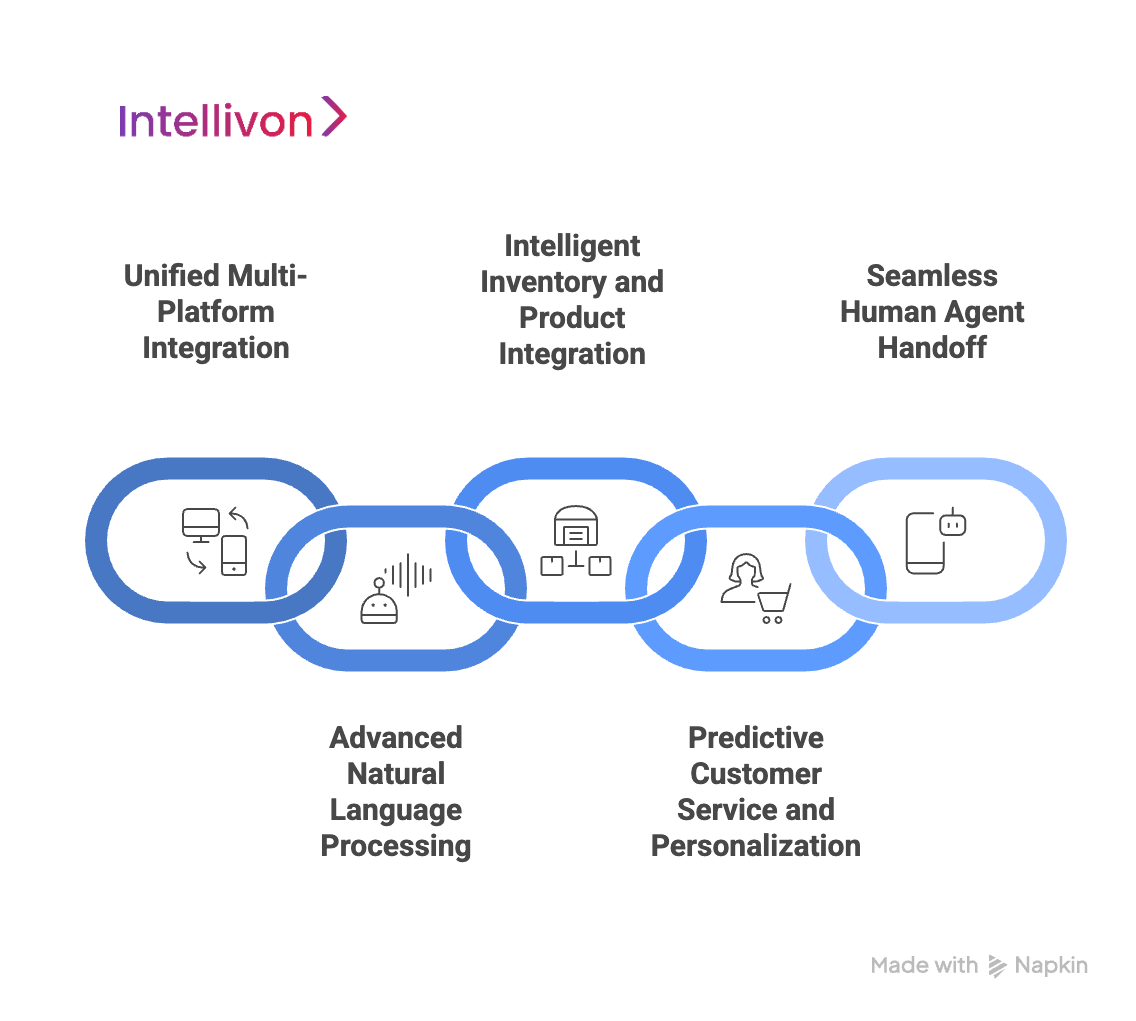
1. Unified Multi-Platform Integration
The foundation of effective custom AI chatbots lies in their ability to operate seamlessly across every customer touchpoint. Unlike basic chatbots that function in isolation, custom AI solutions chatbots natively with websites, mobile applications, social media platforms, in-store kiosks, and even voice-activated devices. This integration ensures that customers experience consistent service quality whether they’re browsing on their smartphone during their commute, chatting via Facebook Messenger, or seeking assistance at an in-store terminal.
The technical architecture behind this integration is sophisticated yet invisible to customers. When a customer starts a conversation on one platform and continues it on another, the AI maintains complete context, conversation history, and customer preferences. This continuity eliminates the frustration of repeating information and creates a truly unified brand experience that reflects how modern consumers actually shop.
2. Advanced Natural Language Processing
Custom AI chatbots leverage sophisticated natural language processing capabilities that extend far beyond keyword recognition. They understand context, intent, and even emotional nuances in customer communications. This means they can interpret complex queries like “I need something similar to what I bought last month but in a different color and size” and provide accurate, relevant responses based on the customer’s purchase history and current inventory.
The NLP capabilities also extend to multilingual support for global retailers, understanding regional dialects, cultural contexts, and market-specific terminology. This linguistic intelligence ensures that customers receive culturally appropriate responses that align with local business practices and communication styles.
3. Intelligent Inventory and Product Integration
One of the most powerful features of custom retail AI chatbots is their real-time integration with inventory management systems. They can instantly check stock levels across multiple locations, provide accurate delivery estimates, and even suggest alternative products when preferred items are unavailable. This capability transforms customer service from a reactive function into a proactive sales and customer satisfaction tool.
The integration extends to comprehensive product knowledge, including detailed specifications, compatibility information, sizing guides, and care instructions. When customers ask complex product questions, the AI can provide detailed, accurate responses that would typically require specialist human knowledge.
4. Predictive Customer Service and Personalization
Custom AI chatbots excel at predictive analytics, using customer data to anticipate needs and proactively address potential issues. They can identify patterns that suggest a customer might need reordering reminders, warranty information, or product care advice. This proactive approach transforms customer service from problem-solving to relationship-building.
Personalization extends beyond using customer names. The AI understands individual shopping preferences, seasonal buying patterns, budget considerations, and lifestyle factors. This understanding enables highly targeted product recommendations, personalized promotional offers, and customized shopping experiences that feel genuinely helpful rather than intrusive.
5. Seamless Human Agent Handoff
Despite their sophisticated capabilities, custom AI chatbots recognize when human expertise is required. The intelligent escalation system identifies complex issues, emotional situations, or specialized product inquiries that need human attention. When handoff occurs, the AI provides the human agent with complete context, conversation history, and relevant customer information, ensuring seamless continuity.
This handoff capability includes intelligent routing, directing customers to agents with specific expertise relevant to their inquiry. Whether it’s a technical product question, a billing dispute, or a complex return situation, customers reach the right specialist equipped with all the necessary context to resolve their issue efficiently.
Making Custom AI Chatbots Flexible for Evolving Retail Enterprise
In today’s fast-paced retail environment, businesses need solutions that can adapt to ongoing changes. Custom AI chatbots, designed for flexibility, offer retail enterprises a powerful tool to respond to dynamic market conditions, evolving customer expectations, and expanding business models. These adaptable systems go beyond the capabilities of off-the-shelf solutions by providing the agility necessary to keep up with the changing needs of modern retail.
1. Adaptive Architecture for Dynamic Business Needs
Retail enterprises are constantly adjusting to new product lines, shifting market trends, and changing customer behaviors. Custom AI chatbots built with adaptive architecture ensure that businesses can evolve without being held back by rigid systems. Unlike traditional chatbots, which may require extensive reprogramming for each change, flexible AI systems are designed with modular components that can adjust as the business grows.
Real-World Example:
Zara has adopted a flexible AI system that adapts to regional business practices, integrating new languages and localized shopping habits. As the brand expanded into new markets, their chatbot was able to instantly adjust to the needs of local customers, helping them understand regional trends and product availability.
2. Scalable Learning and Intelligence Evolution
One of the most advanced features of flexible AI chatbots is their ability to continuously learn and adapt. Traditional chatbots rely on static programming, but AI chatbots use machine learning algorithms to improve their performance over time based on real customer interactions.
As customer behaviors evolve, these AI systems learn from each interaction, adjusting their responses, identifying new trends, and even predicting future customer needs. This learning capability transforms the chatbot from a reactive tool into a proactive asset that can anticipate customer inquiries before they arise.
Real-World Example:
L’Oréal has implemented AI chatbots that track changing customer preferences over time. For instance, when customers start asking about a new skincare ingredient, the chatbot alerts the marketing team while updating the knowledge base to offer more relevant responses, ensuring that future customers receive the right information instantly.
3. Integration Flexibility and System Compatibility
Retail operations rely on a variety of technologies that need to work together seamlessly. Flexible AI chatbots are designed with API-first architectures that make it easy to integrate with other systems, third-party applications, and emerging retail technologies. This allows businesses to connect their chatbots to critical systems like inventory management, CRM platforms, and payment solutions without disrupting daily operations.
Real-World Example:
Best Buy has created an integrated experience where its AI chatbot connects with multiple systems across the business. It pulls real-time data from inventory management, processes returns, and offers product recommendations, all while ensuring smooth integration with their existing platforms. As the retail tech landscape evolves, their AI chatbot can integrate new systems like voice commerce or augmented reality without any disruptions.
4. Customizable Response Strategies and Business Logic
Retailers have distinct business processes, varying customer service needs, and different approaches to brand communication. Flexible AI chatbots can be customized to reflect these unique aspects, enabling businesses to modify conversation flows, adjust response strategies, and fine-tune recommendation algorithms as needed. These customizations can be easily updated without requiring technical expertise, allowing marketing and customer service teams to adapt to business changes swiftly.
Real-World Example:
H&M has tailored its AI chatbot to reflect seasonal campaigns, promotions, and new product launches. When launching a new collection, the chatbot adjusts its response algorithms to highlight relevant products, and it also changes the tone and style of interactions based on the campaign’s objectives. This allows the company to provide a personalized and timely experience to customers throughout the year.
5. Future-Proofing Through Continuous Innovation
Flexible AI chatbots are built with long-term innovation in mind. These systems are designed to incorporate emerging technologies and advanced capabilities as they become available. This future-proofing approach ensures that the chatbot remains relevant as retail technology evolves.
By implementing AI chatbots with a focus on adaptability, businesses are making an investment in the future. As AI capabilities continue to advance, these systems can integrate new features like advanced natural language processing, predictive analytics, and even integration with new technologies like augmented reality or blockchain, positioning the brand to stay ahead of the competition.
Real-World Example:
Amazon continually enhances its AI chatbot capabilities by integrating cutting-edge technologies. As AI evolves, Amazon’s system can seamlessly incorporate new features, such as voice-based shopping or augmented reality experiences, without requiring an overhaul of the existing infrastructure. This adaptability has kept Amazon at the forefront of eCommerce and customer service innovation.
Step-by-Step Process of How We Develop Custom AI Chatbots
Successful implementation of custom AI chatbots involves a clear, step-by-step process. At Intellivon, each development step is designed to ensure that your solution is tailored to your enterprise needs, seamlessly integrates with your existing systems, and evolves alongside your enterprise. Here’s how we approach the deployment of custom AI chatbots for retail enterprises.
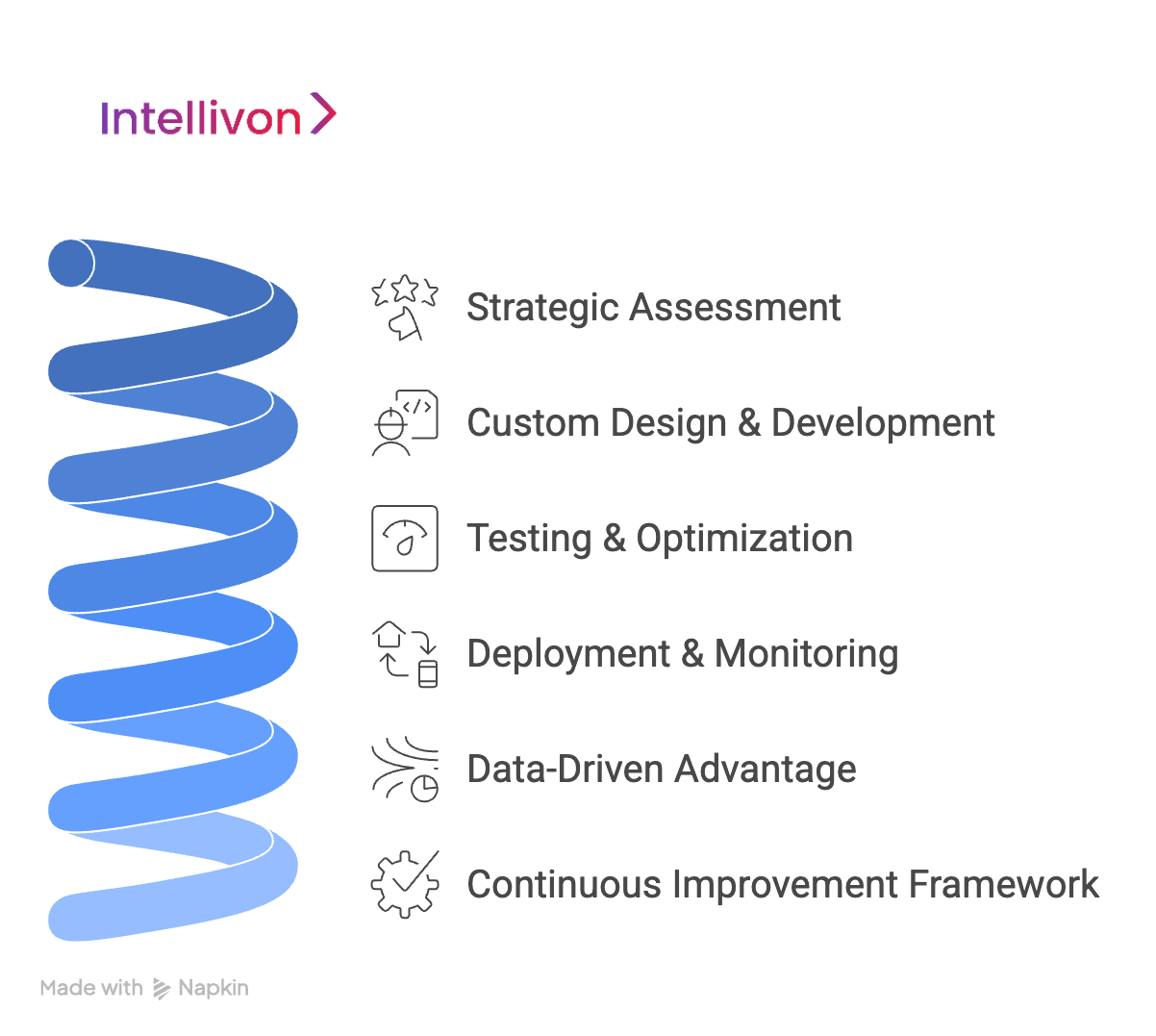
1. Strategic Assessment
- Audit Existing Customer Touchpoints
Our developers audit all your current customer touchpoints. This includes reviewing how customers engage with your brand, whether via your website, mobile app, social media, or in-store experiences, so we can identify areas for improvement and optimization. - Map Customer Journeys and Identify Pain Points
Understanding the customer journey is key. We analyze the paths your customers take, from initial inquiry to purchase, and identify pain points that hinder their experience. This helps us understand where AI can make the most impact. - Review Technical Architecture and Integration Needs
We assess your existing technical setup to ensure that the new AI chatbot will seamlessly integrate with your current systems. This includes reviewing your CRM, ERP, and other relevant platforms to identify any potential integration challenges. - Define Success Metrics and Project ROI
With a clear understanding of your business goals, we define measurable success metrics. These metrics will guide the project and help project potential ROI, whether that’s improving customer satisfaction, reducing support costs, or boosting sales conversions.
2. Custom Design & Development
- Train AI with Your Specific Product Catalogs and Policies
We train the AI chatbot with your specific product catalogs, pricing, return policies, and other key business rules. This ensures that the chatbot understands your offerings and can provide accurate, relevant responses to customer inquiries. - Develop Custom Workflows for Business Processes
We design and implement custom workflows tailored to your business processes, such as order management, returns, and customer service escalations. This ensures the AI chatbot aligns with your existing operations and can handle specific scenarios effectively. - Integrate with Existing Systems
We integrate the chatbot with your existing systems, including your CRM, inventory management, and POS systems. This integration allows the chatbot to provide real-time, accurate information about product availability, order status, and customer data. - Prepare for Multi-Channel Deployment
During this stage, we ensure that the AI chatbot is ready to be deployed across all customer touchpoints, whether that’s on your website, mobile app, social media, or in-store kiosks, ensuring a seamless customer experience across channels.
3. Testing & Optimization
- Test Across All Channels and Scenarios
Comprehensive testing is conducted across all customer touchpoints, simulating real-world interactions to ensure that the AI chatbot performs effectively in every scenario. This includes testing for accuracy, response time, and adaptability. - Optimize Performance and Conduct Load Testing
To ensure the chatbot can handle high volumes of traffic, we conduct performance optimization and load testing. This guarantees the system will function smoothly even during peak times, such as sales events or seasonal spikes. - Conduct User Acceptance Testing (UAT)
Your customer service team participates in user acceptance testing to ensure the AI chatbot meets your operational requirements. This step provides valuable feedback to fine-tune the system before it’s fully deployed. - Verify Security and Compliance
We ensure that the chatbot meets all necessary security and compliance standards, particularly around data privacy and payment processing, so your customers can engage with confidence.
4. Deployment & Monitoring
- Initiate Phased Rollout and Monitor Performance
A phased rollout process is initiated, deploying the AI chatbot across your selected channels while continuously monitoring its performance. This allows us to address any issues quickly and ensure a smooth transition to full-scale deployment. - Track Real-Time Performance and Adjust
We track the chatbot’s performance in real time, making adjustments based on the data. This includes fine-tuning responses, optimizing workflows, and addressing any issues that arise to maintain a consistent, high-quality experience. - Provide Staff Training and Change Management Support
We provide comprehensive training for your staff to ensure they understand how to use the chatbot effectively. Additionally, we offer ongoing change management support to help your team adjust to the new technology and processes. - Optimize Based on Customer Feedback
Once deployed, we actively collect feedback from customers to identify areas for improvement. This feedback loop allows us to make necessary adjustments, optimizing the chatbot’s performance based on real user experiences.
5. Data-Driven Advantage
Custom AI chatbots generate valuable data that can be leveraged to continuously improve both the chatbot and your overall business strategy. Here’s how we integrate data into the process:
- Real-Time Conversation Analysis and Sentiment Tracking
We monitor conversations in real time to gauge customer sentiment and identify trends. This data helps us understand customer satisfaction levels and pinpoint areas where improvements are needed. - Customer Satisfaction Scoring and Trend Identification
Using sentiment analysis and satisfaction scoring, we track how well the chatbot is performing. Trends are identified, helping us adjust the system to meet customer expectations more effectively. - Benchmark Performance Against Industry Standards
We benchmark the chatbot’s performance against industry standards to ensure it’s providing a competitive level of service. This benchmarking helps us identify areas where the system can be further optimized. - Provide Predictive Insights for Business Strategy Optimization
The data generated by the chatbot also provides valuable predictive insights that help optimize your business strategy. We identify emerging trends, new customer needs, and potential areas for business expansion.
6. Continuous Improvement Framework
The implementation of a custom AI chatbot doesn’t end at deployment. Continuous improvement is key to maximizing its value. Here’s how we ensure the system keeps evolving:
- Monthly Performance Reviews and Optimization Recommendations
We conduct monthly reviews to assess the chatbot’s performance and provide optimization recommendations. This ensures that the system continues to perform at its best. - Strategic Assessments and Capability Enhancements
We conduct a strategic assessment to review how the chatbot aligns with your business goals. We then recommend new capabilities or adjustments to ensure the chatbot stays aligned with your evolving needs. - Technology Updates and Feature Expansions
As AI technology continues to advance, we ensure your chatbot remains up-to-date by providing updates and adding new features to enhance its capabilities. - Ongoing Training Data Refinement
We continuously refine the training data based on ongoing customer interactions. This ensures that the AI system becomes more accurate and capable of handling a broader range of inquiries over time.
Cost of Developing a Custom AI Chatbot for Omnichannel Retail Support
We specialize in providing cost-effective, high-quality custom AI chatbot solutions for businesses. Our approach ensures that clients receive maximum value from their investment, without compromising on quality or performance. We design each chatbot to meet the unique needs of your enterprise, integrating seamlessly with your existing systems and workflows.
| Development Phase | Cost Range | Details |
| 1. Strategic Assessment and Planning | $5,000 – $8,000 | – Comprehensive audit of existing touchpoints
– Customer journey mapping – Technical architecture review – Success metrics and ROI projections |
| 2. Custom Design & Development | $15,000 – $30,000 | – AI training with product catalogs and policies
– Custom workflow development – Integration with existing systems – Multi-channel deployment preparation |
| 3. Testing & Optimization | $7,000 – $12,000 | – Comprehensive testing
– Performance optimization and load testing – User acceptance testing – Security and compliance verification |
| 4. Deployment & Monitoring | $5,000 – $8,000 | – Phased rollout and monitoring
– Real-time performance tracking – Staff training and change management – Ongoing optimization based on feedback |
| 5. Ongoing Maintenance and Continuous Improvement | $3,000 – $6,000/month | – Monthly performance reviews
– Quarterly assessments – Annual updates and feature expansions – Ongoing data refinement and model retraining |
| Total Estimated Costs (Initial Development + 1 Year of Maintenance) | $50,000 – $100,000 | – Estimated for initial development plus 1 year of ongoing maintenance and optimization |
The figures provided here are estimates, with the total cost ranging between $50,000 and $100,000. For a more precise quote tailored to your specific project needs, get on a free strategy call with us to map out the specifics of your custom AI chatbot.
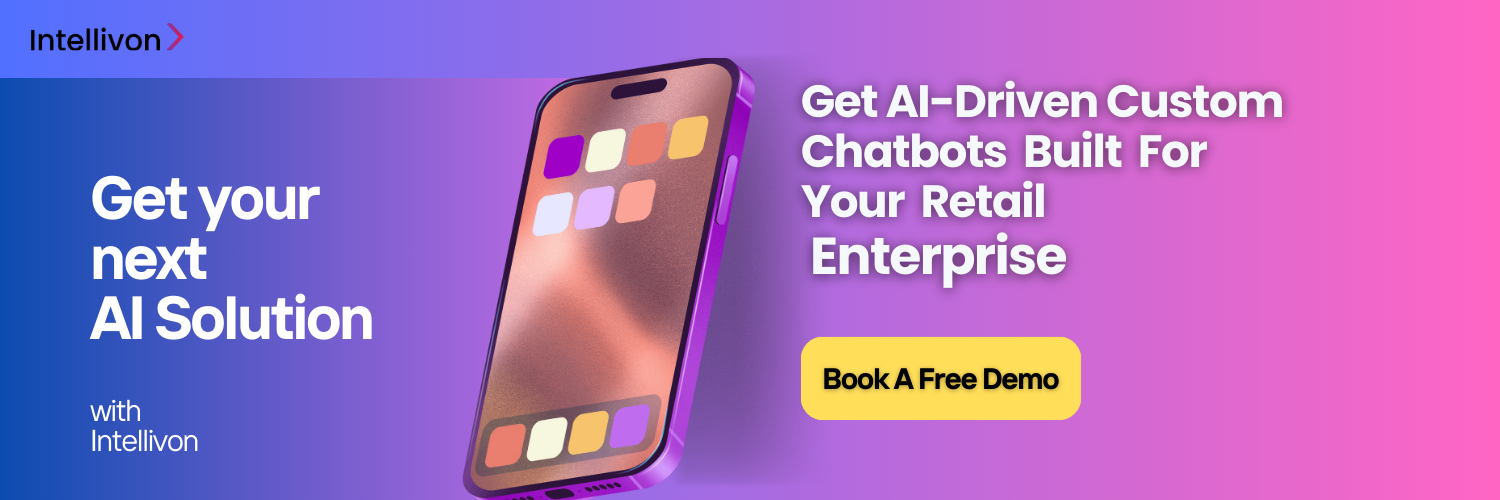
Real-World Success of Custom AI Chatbots for Retail Enterprises
Custom AI chatbots are proving to be transformative for retail enterprises, enhancing customer service, boosting engagement, and driving sales. Here are five real-world examples showcasing their success:

Sephora’s Virtual Artist chatbot offers personalized beauty product recommendations by using AI to analyze customer preferences. 50% of Sephora’s customers engage with the chatbot to discover products, significantly increasing conversion rates and improving overall customer satisfaction. This AI-driven approach has become a key asset in Sephora’s omnichannel strategy, streamlining the shopping experience.

H&M deployed the Ada chatbot to handle a variety of customer service inquiries, including product availability, order tracking, and store locations. By integrating real-time inventory data, the chatbot has cut response times by 50%, providing faster service and enhancing customer engagement. The solution has not only improved operational efficiency but also contributed to better customer experiences across digital touchpoints.

Macy’s launched the Macy’s On Call chatbot to guide in-store customers to their desired products and provide store information. This custom AI solution led to a 60% reduction in inquiries to service desks, allowing employees to focus on more complex tasks. With the ability to handle 10,000+ daily queries, the chatbot has significantly improved the in-store experience, increasing customer satisfaction.
4. L’Oréal

L’Oréal’s ModiFace chatbot leverages AI and augmented reality to offer personalized skincare and makeup advice. The chatbot has contributed to a 30% increase in sales during promotional campaigns by allowing customers to virtually try on products, enhancing the shopping experience and boosting purchase confidence. This innovation has positioned L’Oréal as a leader in AI-driven beauty retail.

Lidl’s AI-powered chatbot handles frequently asked questions, allowing the company to resolve 70% of inquiries without human intervention. This automation has led to a 40% increase in customer retention and enhanced overall satisfaction, as customers can receive instant responses to common queries, creating a more efficient support system.
The Future of Custom AI Chatbots in Omnichannel Retail
The future of retail is closely tied to the integration of AI chatbots into every aspect of the customer journey, transforming traditional support interactions into intelligent commerce experiences. By 2027, it’s expected that over 90% of initial customer interactions will be handled by conversational AI, fundamentally changing the way retailers engage with customers across multiple channels.
1. Predictive Intelligence and Proactive Engagement
The most transformative shift in AI chatbots will be their ability to predict customer needs before they arise. Future chatbots will analyze patterns in customer behavior, purchase history, and external factors to identify potential issues ahead of time. This proactive service will help customers avoid problems rather than just solving them when they occur.
Scenario: A customer might receive a proactive notification from a chatbot if their preferred product is about to go out of stock, or the chatbot might inform them of potential delivery delays before they contact customer service. This will improve satisfaction by addressing issues preemptively and reducing service workload.
2. Immersive Technology Integration
AI chatbots will integrate with augmented reality (AR) and virtual reality (VR) to create immersive shopping experiences. Customers will be able to try on clothes virtually, visualize furniture in their homes, or test beauty products in AR, all while interacting with AI assistants.
Scenario: A customer shopping for furniture might use an AR app to see how a sofa looks in their living room while getting recommendations from a chatbot about matching accessories. This level of interaction will be particularly useful for industries like fashion and furniture.
3. Advanced Emotional Intelligence and Sentiment Analysis
Future AI chatbots will understand customer emotions through text analysis, voice tone, and even facial expressions in video interactions. This emotional intelligence will allow them to adapt their responses based on the customer’s emotional state.
Scenario: If a customer expresses frustration about a late delivery, the chatbot will recognize this and offer empathetic responses, possibly escalating the issue to a human agent if necessary. This approach will make customer service more human-like and responsive.
4. Hyper-Personalization Through Advanced Analytics
AI chatbots will use advanced machine learning algorithms to offer deeply personalized experiences. By analyzing data from past purchases, browsing behavior, and even external factors like weather, chatbots will offer tailored product recommendations and support.
Scenario: A chatbot could suggest winter coats when it detects colder weather in the customer’s location or recommend fitness equipment based on the customer’s fitness goals tracked by their smart devices. This level of personalization will enhance the overall shopping experience.
5. Voice Commerce and Conversational Shopping
Voice-activated shopping will become a significant part of the retail landscape, with AI chatbots handling voice commerce interactions across multiple platforms. Customers will be able to research products, make purchases, and manage orders via voice commands.
Scenario: A customer may use a smart speaker to ask for the best-selling headphones and then place an order, all through a conversational interface. The chatbot will maintain continuity across devices, ensuring the customer’s experience remains seamless.
6. Autonomous Decision-Making and Business Process Integration
AI chatbots will evolve to make autonomous decisions in customer service, such as approving returns or processing refunds, without needing human intervention. These decisions will be based on predefined business rules and real-time data.
Scenario: If a customer requests a refund for an item that meets the return criteria, the chatbot can automatically process the return and issue a refund, reducing resolution time and improving customer satisfaction.
7. Collaborative Intelligence with Human Teams
Instead of replacing human agents, future AI chatbots will work alongside them, providing real-time insights and suggested responses to complex inquiries. This collaboration will enhance human capabilities and ensure that the right person handles sensitive issues.
Scenario: When a chatbot detects a sensitive issue, like a product defect or urgent complaint, it will escalate the case to a human agent while providing the agent with relevant customer history and context to facilitate a quicker resolution.
8. Ethical AI and Transparent Customer Relationships
As AI continues to advance, ethical considerations will play a major role in chatbot development. Retailers will need to ensure transparency about how AI is used, how customer data is handled, and what privacy protections are in place.
Scenario: Customers will be clearly informed when interacting with AI and given an option to opt-out or access their data, building trust and reinforcing the retailer’s commitment to privacy and ethical practices.
Conclusion
Custom AI chatbots are essential for global retail enterprises, offering efficient, personalized, and seamless support across all customer touchpoints. By enhancing customer experiences, improving operational efficiency, and providing scalable solutions, they help retailers stay competitive in an increasingly complex market. Investing in AI-powered solutions is key to driving long-term success and maintaining a strong market position.
Ready to Transform Your Customer Experience?
Contact Intellivon today for a comprehensive evaluation of your current customer support landscape. Our AI experts will provide:
- In-depth analysis of omnichannel opportunities
- Tailored ROI projections for your unique business
- A strategic roadmap for AI chatbot implementation and optimization
- Competitive analysis and market positioning insights
Don’t let your competitors set the standard. Take the first step toward building a custom AI chatbot solution that revolutionizes your customer experience. With over 11 years of expertise, Intellivon is the trusted partner for integrating cutting-edge AI solutions into your business.
Why Choose Intellivon?
- End-to-End AI Expertise: We design, deploy, and scale AI-powered workflows specifically tailored to your business needs, ensuring seamless integration with your existing systems.
- Proven Business Impact: Over 500 successful AI projects have helped organizations boost productivity, cut costs, and improve customer satisfaction.
- Cutting-Edge Technology: We use the latest advancements in machine learning and natural language processing to ensure your business stays ahead in the competitive market.
- Seamless Integration: Our solutions integrate effortlessly with CRMs, ERPs, and communication channels, optimizing real-time data flows.
- Human-Centric Change Management: We offer comprehensive training and support to ensure smooth adoption of new systems across your team.
- Continuous Optimization: Our commitment doesn’t end at implementation—we continuously refine and optimize your AI workflows for sustained business value.
Ready to unlock the power of AI for your customer support?
Contact Intellivon today to learn how we can transform your operations and position your business for future success.

FAQ’s
Q1. What are custom AI chatbots for omnichannel retail?
A1. Custom AI chatbots are tailored solutions designed to provide seamless, personalized customer support across multiple channels, such as websites, mobile apps, social media, and in-store kiosks. They are integrated with your business systems to enhance customer interactions, increase efficiency, and improve overall satisfaction.
Q2. How can AI chatbots improve customer service in retail?
A2. AI chatbots improve customer service by offering 24/7 support, providing instant responses, and personalizing customer interactions. They can handle routine queries, process orders, suggest products, and even anticipate future needs, significantly enhancing the customer experience.
Q3. What are the benefits of using AI chatbots for global retail businesses?
A3. For global retailers, AI chatbots offer scalability, efficiency, and consistency across multiple markets and time zones. They help reduce operational costs, handle high volumes of customer interactions, and provide real-time data insights to optimize customer support and sales strategies.
Q4. How do AI chatbots integrate with existing retail systems?
A4. AI chatbots integrate seamlessly with your CRM, ERP, POS, and inventory management systems, ensuring real-time access to customer data, product information, and order history. This integration enables the chatbot to provide accurate responses and facilitate a unified customer experience across all touchpoints.
Q5. What is the future of AI chatbots in retail?
A5. The future of AI chatbots in retail includes predictive intelligence, voice commerce, and integration with emerging technologies like augmented and virtual reality. Chatbots will evolve to handle more complex tasks, anticipate customer needs proactively, and create immersive, personalized shopping experiences that enhance long-term customer loyalty.

